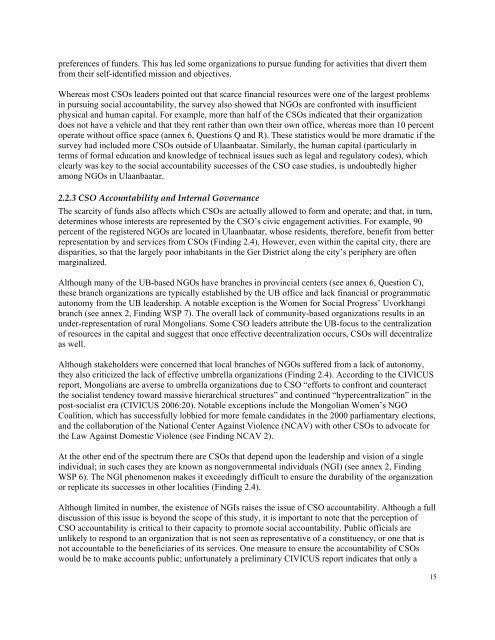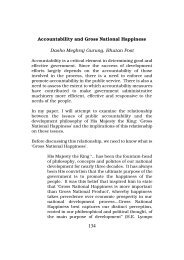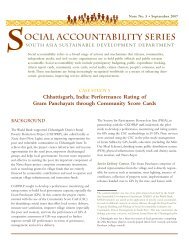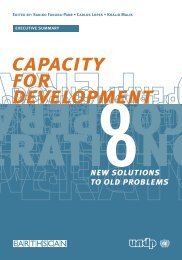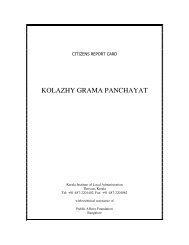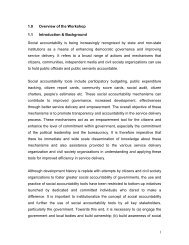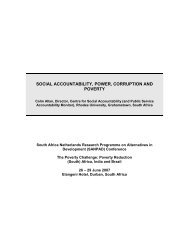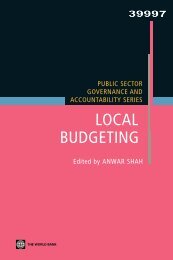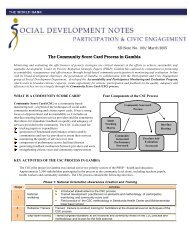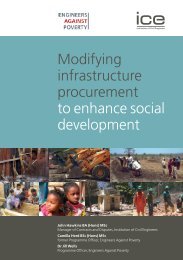Enabling Environment for Social Accountability in ... - SASANet
Enabling Environment for Social Accountability in ... - SASANet
Enabling Environment for Social Accountability in ... - SASANet
Create successful ePaper yourself
Turn your PDF publications into a flip-book with our unique Google optimized e-Paper software.
preferences of funders. This has led some organizations to pursue fund<strong>in</strong>g <strong>for</strong> activities that divert them<br />
from their self-identified mission and objectives.<br />
Whereas most CSOs leaders po<strong>in</strong>ted out that scarce f<strong>in</strong>ancial resources were one of the largest problems<br />
<strong>in</strong> pursu<strong>in</strong>g social accountability, the survey also showed that NGOs are confronted with <strong>in</strong>sufficient<br />
physical and human capital. For example, more than half of the CSOs <strong>in</strong>dicated that their organization<br />
does not have a vehicle and that they rent rather than own their own office, whereas more than 10 percent<br />
operate without office space (annex 6, Questions Q and R). These statistics would be more dramatic if the<br />
survey had <strong>in</strong>cluded more CSOs outside of Ulaanbaatar. Similarly, the human capital (particularly <strong>in</strong><br />
terms of <strong>for</strong>mal education and knowledge of technical issues such as legal and regulatory codes), which<br />
clearly was key to the social accountability successes of the CSO case studies, is undoubtedly higher<br />
among NGOs <strong>in</strong> Ulaanbaatar.<br />
2.2.3 CSO <strong>Accountability</strong> and Internal Governance<br />
The scarcity of funds also affects which CSOs are actually allowed to <strong>for</strong>m and operate; and that, <strong>in</strong> turn,<br />
determ<strong>in</strong>es whose <strong>in</strong>terests are represented by the CSO’s civic engagement activities. For example, 90<br />
percent of the registered NGOs are located <strong>in</strong> Ulaanbaatar, whose residents, there<strong>for</strong>e, benefit from better<br />
representation by and services from CSOs (F<strong>in</strong>d<strong>in</strong>g 2.4). However, even with<strong>in</strong> the capital city, there are<br />
disparities, so that the largely poor <strong>in</strong>habitants <strong>in</strong> the Ger District along the city’s periphery are often<br />
marg<strong>in</strong>alized.<br />
Although many of the UB-based NGOs have branches <strong>in</strong> prov<strong>in</strong>cial centers (see annex 6, Question C),<br />
these branch organizations are typically established by the UB office and lack f<strong>in</strong>ancial or programmatic<br />
autonomy from the UB leadership. A notable exception is the Women <strong>for</strong> <strong>Social</strong> Progress’ Uvorkhangi<br />
branch (see annex 2, F<strong>in</strong>d<strong>in</strong>g WSP 7). The overall lack of community-based organizations results <strong>in</strong> an<br />
under-representation of rural Mongolians. Some CSO leaders attribute the UB-focus to the centralization<br />
of resources <strong>in</strong> the capital and suggest that once effective decentralization occurs, CSOs will decentralize<br />
as well.<br />
Although stakeholders were concerned that local branches of NGOs suffered from a lack of autonomy,<br />
they also criticized the lack of effective umbrella organizations (F<strong>in</strong>d<strong>in</strong>g 2.4). Accord<strong>in</strong>g to the CIVICUS<br />
report, Mongolians are averse to umbrella organizations due to CSO “ef<strong>for</strong>ts to confront and counteract<br />
the socialist tendency toward massive hierarchical structures” and cont<strong>in</strong>ued “hypercentralization” <strong>in</strong> the<br />
post-socialist era (CIVICUS 2006:20). Notable exceptions <strong>in</strong>clude the Mongolian Women’s NGO<br />
Coalition, which has successfully lobbied <strong>for</strong> more female candidates <strong>in</strong> the 2000 parliamentary elections,<br />
and the collaboration of the National Center Aga<strong>in</strong>st Violence (NCAV) with other CSOs to advocate <strong>for</strong><br />
the Law Aga<strong>in</strong>st Domestic Violence (see F<strong>in</strong>d<strong>in</strong>g NCAV 2).<br />
At the other end of the spectrum there are CSOs that depend upon the leadership and vision of a s<strong>in</strong>gle<br />
<strong>in</strong>dividual; <strong>in</strong> such cases they are known as nongovernmental <strong>in</strong>dividuals (NGI) (see annex 2, F<strong>in</strong>d<strong>in</strong>g<br />
WSP 6). The NGI phenomenon makes it exceed<strong>in</strong>gly difficult to ensure the durability of the organization<br />
or replicate its successes <strong>in</strong> other localities (F<strong>in</strong>d<strong>in</strong>g 2.4).<br />
Although limited <strong>in</strong> number, the existence of NGIs raises the issue of CSO accountability. Although a full<br />
discussion of this issue is beyond the scope of this study, it is important to note that the perception of<br />
CSO accountability is critical to their capacity to promote social accountability. Public officials are<br />
unlikely to respond to an organization that is not seen as representative of a constituency, or one that is<br />
not accountable to the beneficiaries of its services. One measure to ensure the accountability of CSOs<br />
would be to make accounts public; un<strong>for</strong>tunately a prelim<strong>in</strong>ary CIVICUS report <strong>in</strong>dicates that only a<br />
15


